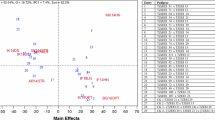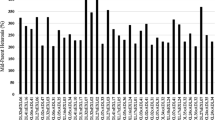Abstract
Yields of maize (Zea mays L.) are remarkably low in sub-Saharan Africa and yet farmers have limited access to improved varieties. The objective of this study was to determine combining ability and heterosis of 18 elite maize inbred lines in environments prone to northern corn leaf blight (NCLB) disease in the mid-altitude tropics. Nine elite inbred lines were crossed as females with nine male lines using the North Carolina Design II mating scheme and 81 hybrids were generated. The hybrids, parents and three standard check varieties were evaluated using an alpha lattice design with two replications across seven environments in the mid-altitude sub-humid agro-ecologies in Ethiopia. The new top ranking hybrids displayed up to 250 % high-parent heterosis and mid-parent heterosis for grain yield and up to −25 % high-parent mid-parent heterosis for NCLB reaction. The specific combining ability (SCA) by site interaction was not significant, suggesting that the top yielding hybrids were relatively stable across environments. Inbred lines such as CML 395, 30H83-7-1, ILO’OE-1-9, 124-b (113), CML202, CML312, and Gibe-1-91 resulted in significant SCA effects for grain yield were selected as promising parents. Lines CML395 and ILO’OE-1-9 had negative and significant general combining ability (GCA) effects for NCLB reaction, implying the resistance of the inbred lines for NCLB. The most performing experimental hybrids such as CML-312 × CML395, CML197 × CML395, CML443 × DE-78-Z-126-3 had high SCA effects and produced mean grain yields of >8 t ha−1. The new hybrids may be used directly for production or as testers in hybrid development with resistance to NCLB.


Similar content being viewed by others
References
Ahmad A, Saleem M (2003) Combining ability analysis in maize. Int J Agric Biol 5:239–244
Alam A, Ahmed S, Begum M, Sultan M (2008) Heterosis and combining ability for grain yield and its contributing characters in maize. Bangladesh J Agric Res 33:375–379
Banziger M, Cooper M (2001) Breeding for low input conditions and consequences for participatory plant breeding: examples from tropical maize and wheat. Euphytica 122:503–519
Bayisa A, Hussein M, Habtamu Z (2008) Combining ability of transitional highland maize inbred lines. East Afr J Sci 2:19–24
CSA (2012) Report on area and production of crops. Agricultural sample survey on private peasant holdings. Central Statistic Authority, Addis Ababa, Ethiopia
Dabholkar AR (1999) Elements of biometrical genetics. Kalyani Publishers, New Delhi
Dagne W (2002) Combining ability analysis for traits of agronomic importance in maize (Zea mays L.) inbred lines with different levels of resistance to grey leaf spot (Cercospora zea maydis). MSc Thesis, Haramaya University, Ethiopia
Dagne W, Vivek BS, Birhanu T, Koste A, Mosisa W, Legesse W (2010) Combining abilitiy and heterotic relationship between CIMMYT and Ethiopian maize inbred lines. Ethiopian J Agric Sci 20:82–93
Dagne W, Labuschagne MT, Vivek B (2012) The influence of water stress on yield and related characteristics in inbred quality protein maize lines and their hybrid progeny. Agric Water Manag 85:112–115
Falconer DS (1989) Introduction to quantitative genetics. Oliver and Boyd, London
Girma T, Fekede A, Temam H, Tewabech T, Eshetu B, Melkamu A, Girma D. Kiros M (2008) Review of maize, sorghum and millet pathology research. In: Tadesse A, Ali K (Eds.) Proceedings of the 14th Conference of the Plant Protection Society of Ethiopia, 19–22 December 2006, Addis Ababa, Ethiopia, p. 49–55
Hallauer AR, Miranda JB (1988) Quantitative genetics in maize breeding. Iowa State University Press, Ames
Kanyamasoro MG, Karungi J, Asea G, Gibson P (2012) Determination of the heterotic groups of maize inbred lines and the inheritance of their resistance to the maize weevil. Afr Crop Sci J 20:23–34
Legesse W, Pixley KV, Botha AM (2009) Combining ability and heterotic grouping of highland transition maize inbred lines. Maydica 54:1–9
Meseka S, Menkir A, Ibrahim A, Ajala S (2006) Genetic analysis of performance of maize inbred lines selected for tolerance to drought under low nitrogen. Maydica 51:487–494
Mosa H (2010) Estimation of combining ability of maize inbred lines using a top cross mating design. J Agric Res 36:13–16
Mosisa W, Banziger M, Friesen D, Erley Schulte Ayfm, Horst WJ, Vivek BS (2008) Relative importance of general combining ability and specific combining ability among tropical maize (Zea mays L.) inbreds under contrasting nitrogen environments. Maydica 53:279–288
Rahman HZ, Shah S, Shah M, Khalil I (2012) Evaluation of maize S2 lines in test crosses combinations II: yield and yield components. Pak J Bot 44:187–192
Rojas BA, Sprague GF (1952) A comparison of variance components in corn yield traits; general and specific combining abilities and their interaction with locations and years. Agron J 44:462–466
SAS (2002) Statistical Analysis System, Version 9.0, SAS Institute, Inc., Cary, NC, USA
Sharma JR (1998) Statistical and biometrical methods in plant breeding. New Age International, New Dehli
Singh RK, Chaudhary BD (1985) Biometrical methods in quantitative genetics analysis. Kalyani Publishers, New Delhi-Ludhiana
Wende A, Hussein S, Derera J, Mosisa W, Laing MD (2013) Preferences and constraints of maize farmers in the development and adoption of improved varieties in the mid-altitude, sub-humid agro-ecology of western Ethiopia. Afr J Agric Res 8:1245–1254
Wheeler BEJ (1969) An introduction to plant diseases. Wiley and Sons, London 347
Worku M, Tuna H, Nigussie M, Deressa A (2001) Maize production trends and research in Ethiopia. In: Nigise M, Tanner D (Eds.). Enhancing the contribution of maize to food security in Ethiopia. Proceedings of the 2nd national maize work shop of Ethiopia, 12–16 November 2001, EARO/CIMMYT, Addis Ababa, Ethiopia, pp. 47–50
Xingming F, Jing T, Bihua H, Feng L (2001) Analyses of combining ability and heterotic groups of yellow grain quality protein maize inbreds. In: Friesen DK, Palmer FAE (Eds.). Integrated Approach to Higher Maize Productivity in the New Millennium. Proceeding of the 7th Eastern Southern Africa Regional Maize Conference. 5–11 February 2002, CIMMYT/KARI, Nairobi, Kenya, pp. 143–148
Zeleke H, Tuna H (2010) Combining ability analysis for yield and related traits in quality protein maize (Zea mays L.) inbred lines. Int J Biol Sci 2:2010–2015
Acknowledgments
The Alliance for a Green Revolution in Africa (AGRA) is sincerely thanked for financial support of the study. The Ethiopian Institute of Agricultural Research (EIAR) is acknowledged for providing the first author’s leave of absence and for hosting the field research. The all-round support provided by the national maize research program of Ethiopia is highly appreciated. The International Maize and Wheat Improvement Center (CIMMYT) is sincerely thanked for providing some of the inbred lines.
Author information
Authors and Affiliations
Corresponding author
Electronic supplementary material
Below is the link to the electronic supplementary material.
Rights and permissions
About this article
Cite this article
Abera, W., Hussein, S., Derera, J. et al. Heterosis and combining ability of elite maize inbred lines under northern corn leaf blight disease prone environments of the mid-altitude tropics. Euphytica 208, 391–400 (2016). https://doi.org/10.1007/s10681-015-1619-5
Received:
Accepted:
Published:
Issue Date:
DOI: https://doi.org/10.1007/s10681-015-1619-5




